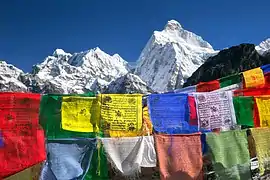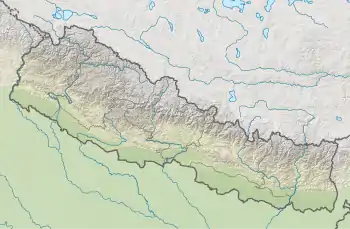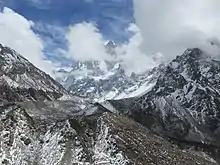Kumbhakarna Mountain
Mount Kumbhakarna or Jannu (Limbu: Phoktanglungma) is the 32nd highest mountain in the world. It is an important western outlier of Kangchenjunga, the world's third highest peak. Kumbhakarna is a large and steep peak in its own right, and has numerous challenging climbing routes.
| Kumbhakarna | |
|---|---|
| Jannu | |
 Jannu from the south | |
| Highest point | |
| Elevation | 7,710 m (25,300 ft) [1] Ranked 32nd |
| Prominence | 1,035 m (3,396 ft) |
| Listing | List of mountains in Nepal |
| Coordinates | 27°40′58″N 88°02′45″E |
| Geography | |
 Kumbhakarna Location in Nepal | |
| Location | Eastern Nepal |
| Parent range | Himalayas |
| Climbing | |
| First ascent | April 27–28, 1962 by René Desmaison, Paul Keller, Robert Paragot, Gyalzen Mitchung Sherpa, Lionel Terray, André Bertraud, Jean Bouvier, Pierre Leroux, Yves Pollet-Villard, Jean Ravier and Wangdi Sherpa |
| Easiest route | rock/snow/ice climb |
The official name of this peak is Kumbhakarna, but the designation Jannu is still better known. It is called Phoktanglungma, literally "mountain with shoulders" (phoktang means shoulder and lungma means mountain), in the Limbu language, and is sacred in the Kirant religion.
Location
Kumbhakarna is the highest peak of the Kumbhakarna Section of the Kangchenjunga Himal (using H. Adams Carter's classification[2]), which straddles the border between Nepal and Sikkim, and lies entirely within Nepal. A long ridge connects it with Kangchenjunga to the east.
Notable features
Kumbhakarna is the 32nd highest mountain in the world (using a cutoff of 500m prominence, or re-ascent). It is more notable for its climbing challenge, and is one of the hardest peaks in the world in terms of technical difficulty because of its complex structure, its vertical relief, and the particularly steep climbing near the summit. The north face, in particular, has been the scene of some of the most technical (and controversial) climbing achieved at altitudes over 7000m.
Climbing history
Kumbhakarna Jannu was first reconnoitered in 1957 by Guido Magnone, and first attempted in 1959 by a French team led by Jean Franco. It was first climbed in 1962 by a team led by the French alpinist Lionel Terray. Those reaching the summit were René Desmaison, Paul Keller, Robert Paragot and Gyalzen Mitchung Sherpa (April 27) and Lionel Terray, André Bertraud, Jean Bouvier, Pierre Leroux, Yves Pollet-Villard, Jean Ravier and Wangdi Sherpa (April 28).[3][4][5]
Their route started from the Yamatari Glacier south of the peak and followed a circuitous route to the large plateau known as the Throne (a hanging glacier south of the summit), continuing to the summit via the southeast ridge.
The Huge, steep north face (the so-called "Wall of Shadows") was first climbed in 1976 by a Japanese team led by Masatsugu Konishi, by a route that starts on the left side of the face and then meets the east ridge, avoiding the steep headwall at the top of the face (though a New Zealand team had climbed the north face the previous year without proceeding to the summit). A Slovenian climber, Tomo Česen, claimed a solo ascent of a more direct route on the face in 1989, but this claim is considered suspect by many in the climbing community.[4]
In 2004, after a failed attempt the previous year, a Russian team led by Alexander Odintsov succeeded in climbing the direct north face route through the headwall. This required big-wall aid techniques in a sustained, committing setting at over 7500m, a major achievement. However some in the climbing community were upset to learn that the Russians left a good deal of equipment on the wall, provoking a debate over what constitutes appropriate modern style on such a route.[6] Despite the controversy, the team won the Piolet d'Or for the ascent.
The Himalayan Index lists over a dozen ascents of Jannu; there may be others that have not been written up in climbing literature.
Gallery
 Jannu from the west, a pass between Olung and Gyabla
Jannu from the west, a pass between Olung and Gyabla The impressive north face of Jannu
The impressive north face of Jannu

References
- Kangchenjunga (Map). 1:120,000. Cartography by Himalayan Maphouse Pvt Ltd. Nepa Maps. § C6.
- H. Adams Carter, "Classification of the Himalaya", American Alpine Journal 59 (1985), pp. 109–141
- Liz Hawley, Himalayan Database
- Andy Fanshawe and Stephen Venables, Himalaya Alpine Style, Hodder and Stoughton, 1995.
- High Asia: An Illustrated History of the 7000 Metre Peaks by Jill Neate, ISBN 0-89886-238-8
- American Alpine Journal 79 (2005), pp. 56–63.
External links
| Wikimedia Commons has media related to Kumbhakarna Mountain. |
- Himalayan Index
- DEM files for the Himalaya (Corrected versions of SRTM data)